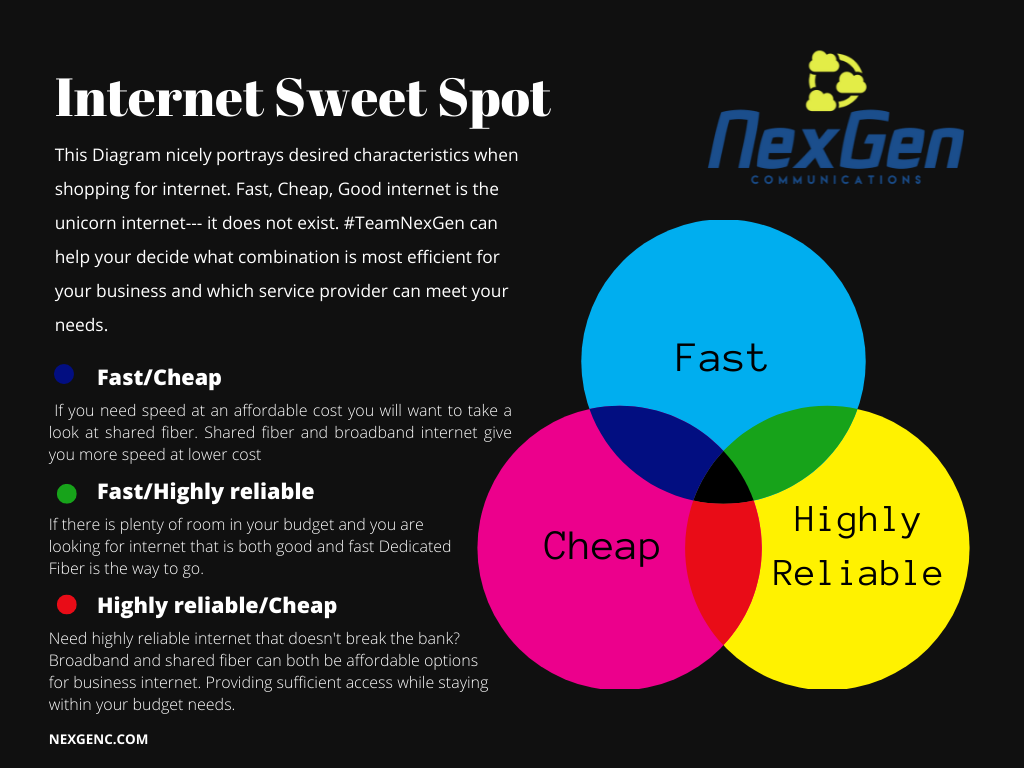
We make decisions about our homes, families and careers every day. Everything from the long-awaited question by every child in every household, “what’s for dinner†to the way we bring our best selves to our careers every day. If you’re a business owner or in charge of making the best decisions for the way a business operates, you know the list of to-do’s and decisions are enough to rob you of your sleep every night.
That is, unless you have a little help. Let us be that help if what you’re facing is a decision about your business’ internet needs and overall technology goals. Today we’ll help you answer: Do I need coax or fiber internet circuits? And what’s the difference anyway?
You’ve heard the analogy about comparing apples and oranges. Broadband vs fiber falls in that category. They may both be a type of internet connection, but they’re far from the same. Let’s start with the basic definition of both.
Broadband: The important lesson here, maybe first and foremost, is vocabulary. Broadband is also called coax and/or copper. If you hear broadband/coax/copper used interchangeably, just know that the following information applies equally to all of it. This kind of connection is made using a coaxial cable. This service is usually shared among a number of subscribers. It’s often referred to as “best effort†service as the users relying on it will only benefit from the best effort speed based on the bandwidth intensive applications using the internet at the same time.
The best analogy here is to remember, broadband is like the slower right-hand lanes of the highway. You’ll still get where you’re going, but not as fast as those speeding down the HOV lane.
Broadband has become much more stable over the last 5 years. It’s even recommended as a primary connection for a lot of businesses. There’s not a guarantee on its upload time, however, it’s become a very good option for a lot of companies. You’ll typically see higher download speeds than upload speeds; asymmetrical speeds can be provided today up to 1.25 gig, soon to be 10 gig, with broadband. This is a great option for a small business or a secondary circuit for a larger company.
Dedicated Fiber: Internet delivered via clusters of transparent glass fibers. The fiber optic cables convert the electrical signals to light. We all know light travels fast and that means the connection results in high speeds. In this point-to-point architecture, the service is dedicated to the customer. The traffic lane analogy works here also. Think of dedicated fiber like the HOV lane of traffic; the dedicated lane of traffic where you can travel faster and get to your destination quicker than those in the “broadband, right-hand lanes.†Most providers allow speeds from 10 mb – 100 gig currently. While most companies won’t need speeds above 1 gig, there are more economical bandwidth amounts ranging from 100 meg to 1 gig speeds.
Dedicated? What does that mean? It’s the truest definition of the old adage, “you get what you pay for.†When you invest in dedicated internet access, you’re paying for guaranteed bandwidth. That means whatever internet speed you’re paying for you benefit from that speed consistency. All dedicated fiber provides symmetrical speeds, that means the speed you’re paying for applies to uploading and downloading online data. You’ll receive a service level agreement when you pay for dedicated fiber; That’s an agreement that sets the expectations between you and your provider. An SLA describes the products or services you’re paying for, a point of contact if you have a problem with your service, and how the resolution process will be monitored and approved.
Shared Fiber: That’s right, not all fiber is created equal. Shared fiber is delivered to multi-tenant buildings by a single strand of optical fiber that supports multiple customers. One strand can serve up to 32 customers. The Fiber is managed via one terminal in the building but then branched out to all the different Suites or Units when clients purchase. Different equipment is used and the termination point is further away in the Main Point of Entry for the building. Shared Fiber is like being in the HOV lane at rush hour, for example..
Shared fiber delivers the same benefits of symmetrical fiber speeds, however, it does not guaranteed uptime mentioned with dedicated fiber. You will not receive a service level agreement with a shared fiber service.
Shared Fiber can be delivered in symmetrical speeds, just like dedicated fiber. There’s an added choice to purchasing a shared fiber circuit; these circuits can also be delivered at asymmetrical speeds. That means your upload speed is about 10% of the download speeds. If you’re wondering why a business would choose a circuit delivering asymmetrical speeds, it may be because the service is less expensive from symmetrical speeds. A business may not view fast uploading speeds as a priority and may choose not to spend the extra money. Today, shared fiber is available from 50 mb to 5 gig depending on your location.
Which is better for your business?
Broadband services and shared fiber services are best suited, in most cases, for smaller businesses or even satellite offices. Both of these connections are often used as a backup or failover connection as well. If an outage or any kind of service interruption happens, the backup, more affordable option can take over and enable businesses to continue to run as normal as possible until the primary connection is restored.
Dedicated fiber services are necessary for larger business, corporations, and data services.
Of course, there’s always a chance the answer comes down to number crunching and your budget. NexGen steps in here to assess your business’ needs, uncover your options, and offer a solution that will set you up for growth. Check out our blog titled “Your Guide To Business Internet Speed†for a deeper look at what you should consider when deciding on the right product for you.
